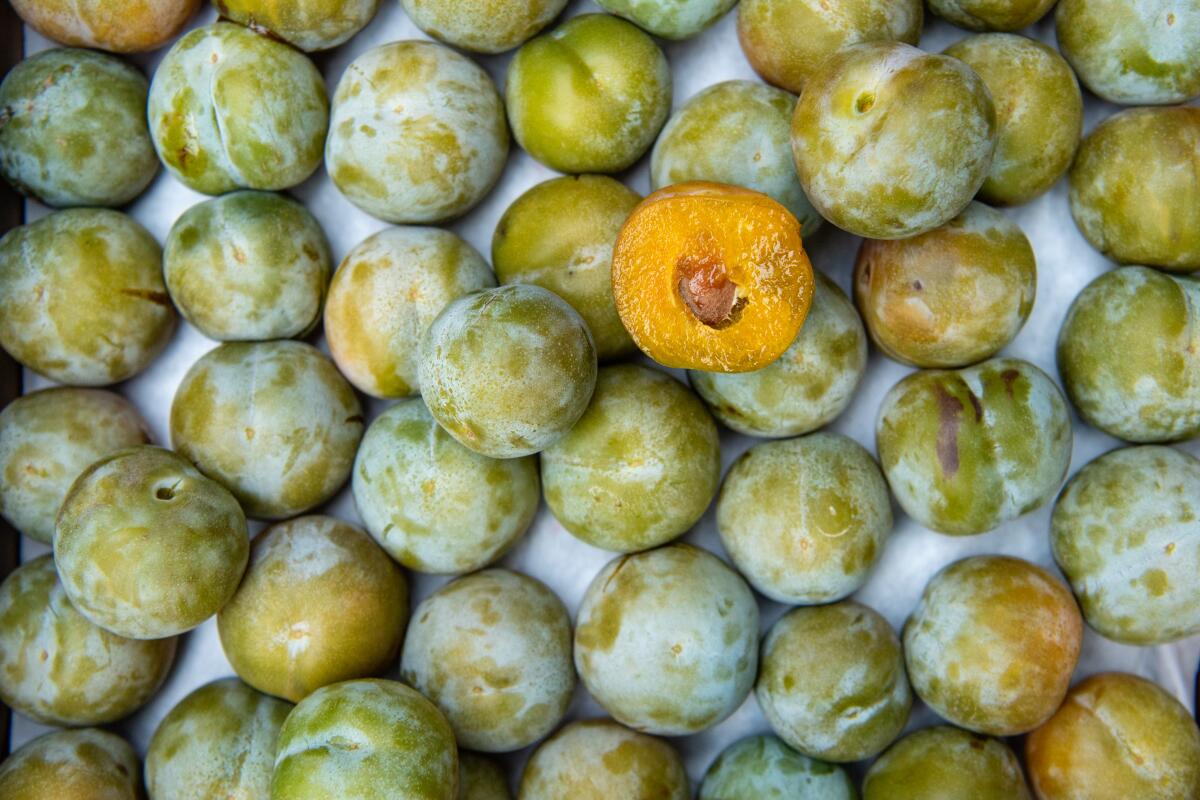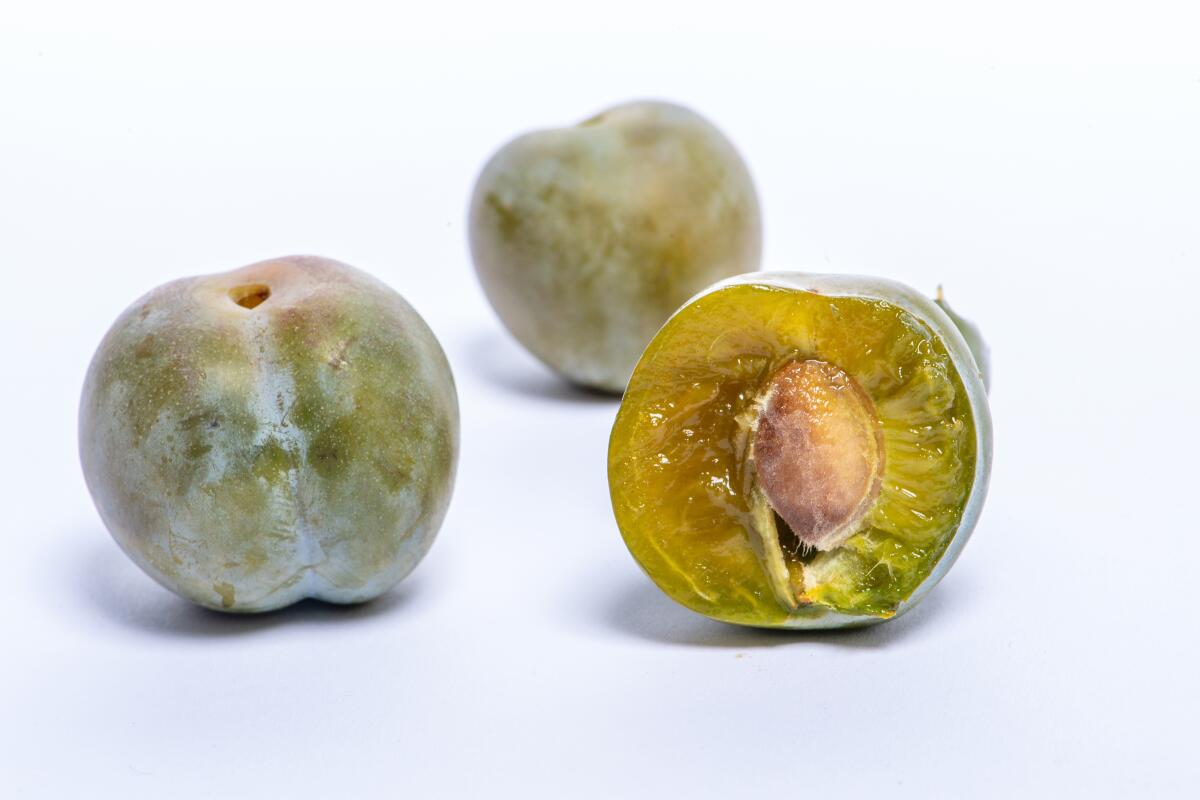The Holy Grail of stone fruit is in season. Get it while (and if) you can

- Share via
Delayed gratification is never a pleasant thing. “I’d gladly pay you Tuesday for a hamburger today,” was a favorite maxim of Wimpy from the “Popeye” cartoons. And so when a friend told me last December about a plum — a very special plum; the plum, perhaps, of all plums — I was naturally excited. And dismayed, simultaneously, at the prospect of a months-long wait to try the fruit.
But seasons passed and the world turned, months turned to weeks, and I eventually found myself in stone fruit season, possibly the best of all seasons. Among the peaches, pluots and apricots, I was really just pining for an opportunity to try one thing: the fussy, elusive greengage plum. The greengage is a small European variety that was once commercially popular but has since been nearly totally overwhelmed by the larger, sturdier Asian plums introduced to this country by Luther Burbank.
The greengages are in season, folks. Right now. And for about a couple of weeks. I got to eat some and if you’re lucky, you might too.
Known as the Reine Claude in France, or Queen Claude, after one of the daughters of Louis XII, the greengage bears a modest, subdued beauty. Called the “queen of plums” by English food writer Edward Bunyan, the greengage indeed has an air of quiet, aristocratic power. No larger than a golf ball, these are a deep shade of asparagus green, save for the lucky few that have been tinged a poppy-like shade of yellowish orange by the sun.
Don’t be fooled, though, into thinking that these are the hard, tart (and delicious) Kelly-green yeşil erik you find inundating the fruit carts of Istanbul during summer. While tiny and seemingly unripe, a greengage is preternaturally sweet, juicy and deeply flavorful but possessing far less tartness and tannic pucker than other, more popular plum varieties.

I approached writer and fruit scholar (and freelance contributor to The Times) David Karp to learn more because, really, who else would I approach? Karp, who became enamored with the greengage as a child, is a silent partner with Andy Mariani in the cultivation of the fruit at Andy’s Orchard in Morgan Hill, Calif., near San Jose. It’s likely the largest single source of commercially available greengages in the United States. Karp and Mariani grow three acres of the plums. “There’s maybe three [orchards] in the whole rest of the country,” Karp said.
Karp’s love of the fruit led him to get involved with the cultivation. “I met Andy years ago and I tasted all these fruits and I thought to myself, ‘Jesus, I can’t drive up there five times a summer in order to get this fruit.’ I became hooked!” But greengages have proved tricky to grow, and it’s apparent to Karp why they’ve fallen out of favor in this country commercially.
He explained that whereas larger Asian varieties can be harvested unripe and shipped cross-country as is, “the greengage, when fully ripe, really is too delicate to be shipped across the country.” He pointed to a few plums that had ripened to the point where the thin skin had begun to crack and split open like a blister. Additionally, greengage trees are alternate bearing, meaning you’ll get an overlarge crop one year and a very tiny one the next. “They are finicky,” Karp said. “They probably require more chill than we can provide here.” Chill hours, or the number of hours spent between 32 and 45 degrees Fahrenheit, are essential for certain fruit trees to “know” when it’s time to come out of dormancy and begin growing.
But for Karp, it’s worth the trouble for this decidedly singular fruit. The sweetness of fruit can be measured with a refractometer by a unit of measurement called Brix — the percentage of sugar, by mass, in 100 grams of a given solution. The juice from your standard plum, Karp said, might barely break into the teens. One greengage he measured registered nearly 38.
This year, lucky for me, is a good year for greengages at Andy’s Orchard, and I got my hands on a couple of pounds. I ate almost all of them in one sitting. Barely-there skin yields immediately to sweet, golden-hued, perfectly textured flesh. The first honeyed bite explodes with preposterous sweetness, a shot of nectar balanced with just enough acidity so that it isn’t cloying. Comparisons to other fruits are hard to make: You could make parallels to the sweetness of a lychee without a lychee’s distinct perfumey bouquet, perhaps (though the greengages have an intoxicating floral scent all their own).
Regardless, I ate them. And ate them. And although I had a slight stomachache that evening, there has never been another that was entirely worth the price. When Clement Clarke Moore penned, “While visions of sugar-plums danced in their heads,” he was certainly not writing about greengages, but he may as well have been. It was all I could think of when I nodded off to sleep that night.
Greengages will be at the Andy’s Orchard stand at the Santa Monica Farmers Market this Wednesday (Aug. 14) and maybe the following week, although there are no guarantees. Call ahead to check availability. Andy’s Orchard, 1615 Half Road, Morgan Hill, (408) 782-7600, AndysOrchard.com
More to Read
Eat your way across L.A.
Get our weekly Tasting Notes newsletter for reviews, news and more.
You may occasionally receive promotional content from the Los Angeles Times.











